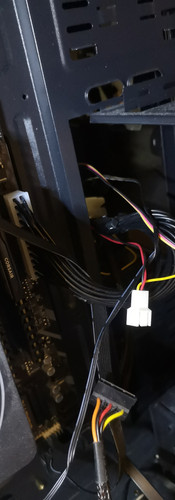(The SCIENCE! Farm) 2 Computers 1 PSU
- Sasha W.

- Apr 16, 2021
- 2 min read
What?
Anyway:
I connected two of my servers to the same power supply. This post is because I am excited about that. Long story short, every voltage transformer from mains (230V) to 12V is creating heat and wasting power unnecessarily, especially as many of my machines have more value-oriented models (barely 80 Plus cert) and this is to eliminate one of those un-needed transformer stages.
So, I have wired two of my (power-optimised: 80W each) 3900X compute machines up to the same power supply - a Seasonic G-series 360W Gold. To do that, I used a 24-pin 2-way splitter (all wires are duplicated, not just the power switch like many have, duh), and cut the sleeve on the PSU's 8-pin EPS/12V CPU cable so that it exposed both halves of the 8-pin; which break into 2 4-pin cables. Despite being on "opposite ends" of the cable to make the 8-pin, these can work in different motherboards as both just carry two 12V+ and two ground wires. They are in fact, keyed identically, too. So all I did was use a CPU power extender on one half
of the cable, and plugged the other half into the first motherboard.
But the cool part, is that I taped two of my cases together, one upside down, with both rear-panels removed so they essentially become one larger, dual-motherboard case; sharing an internal section. It's easy to wire the necessary cables from there, and also ensures that both outer-facing panels are the "main side panel"; so that I can remove them and access the components in both machines, one from each side (also airflow as these cases have vented side panels with fans for the VRMs).
Since both motherboards are now taking 12V, 3.3V and 5V from the PSU via the same 24-pin, I did a few extra bits such as remove the (Firmware access only) display adapters and unplug all the fan headers from the boards except the CPU fans. All the case fans run from the PSU directly via adapters.
I also took the liberty of dismantling the front-panel, removing the unnecessary I/O ports and wires (USB and 3.5mm audio) and routing the LEDs and power/reset buttons to the rear (where I can access them as in the pictures below) and glued them there in a really ghetto yet really functional fashion. Excellent.
And it works. So I'm happy. More efficient power supply system, a spare PSU, and better use of space. Yay.
You can click on the pictures to enlarge them:
So, there you have it. A single box (kinda), with a single power supply, two sockets and 24-cores, 48 threads and quad-channel memory (2x2x4GB).










Comments